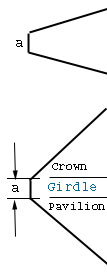As extremely thin and very thin girdles are usually discouraged, should cutter not be told not to cut the diamonds with those to prolong the durability of the diamond, which after all is meant to last forever, or for a few decades anyway without damage?
I take it that the Super ideal diamonds will never have ''very thin'' or ''extremely thin'' as a measurement, is that the case?
I take it that the Super ideal diamonds will never have ''very thin'' or ''extremely thin'' as a measurement, is that the case?








300x240.png)